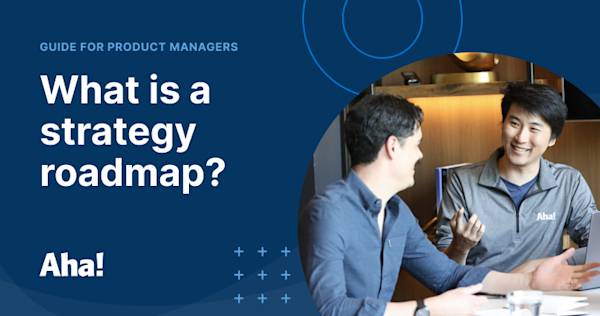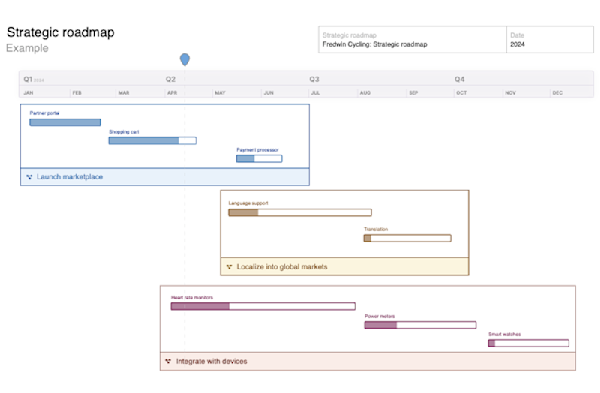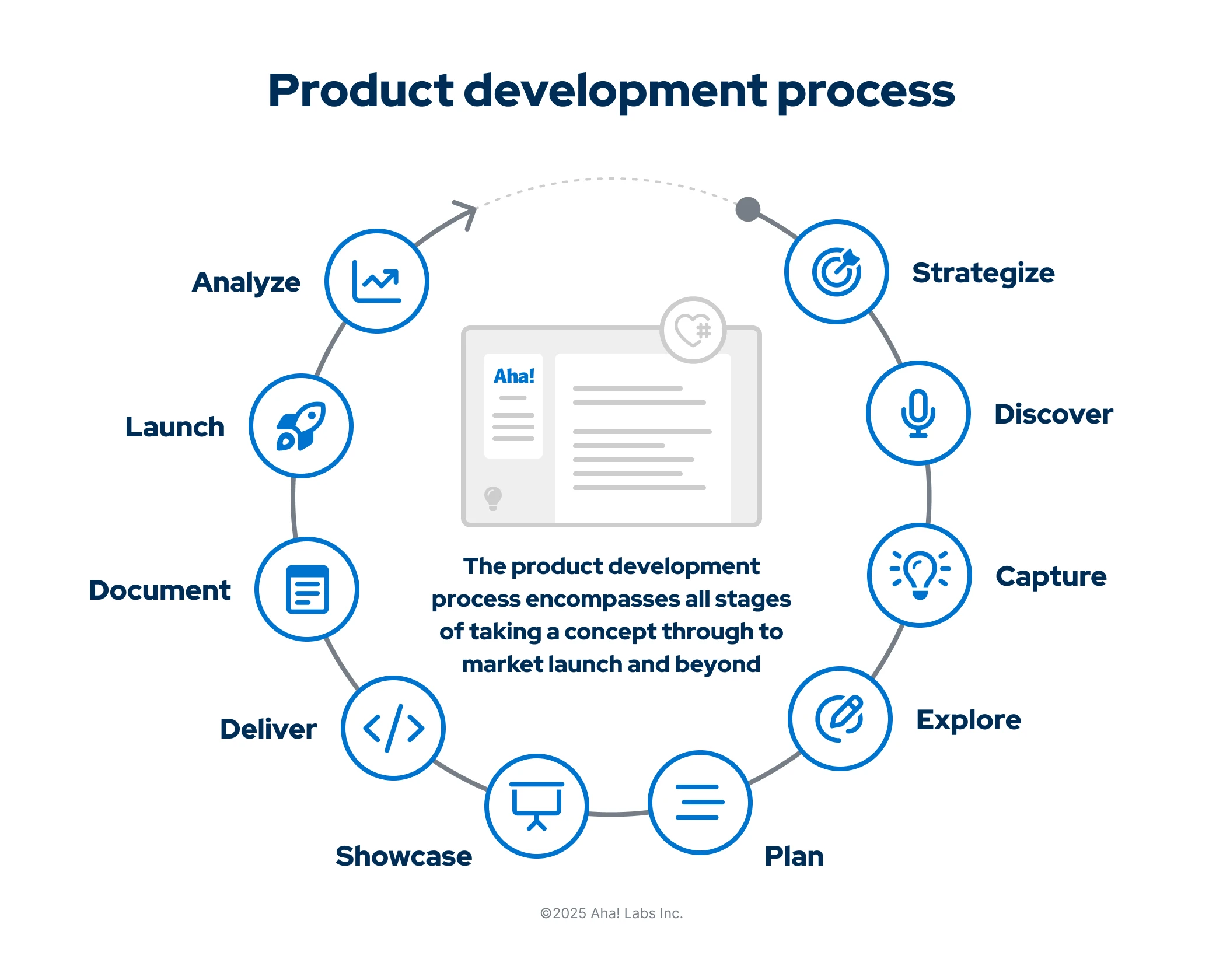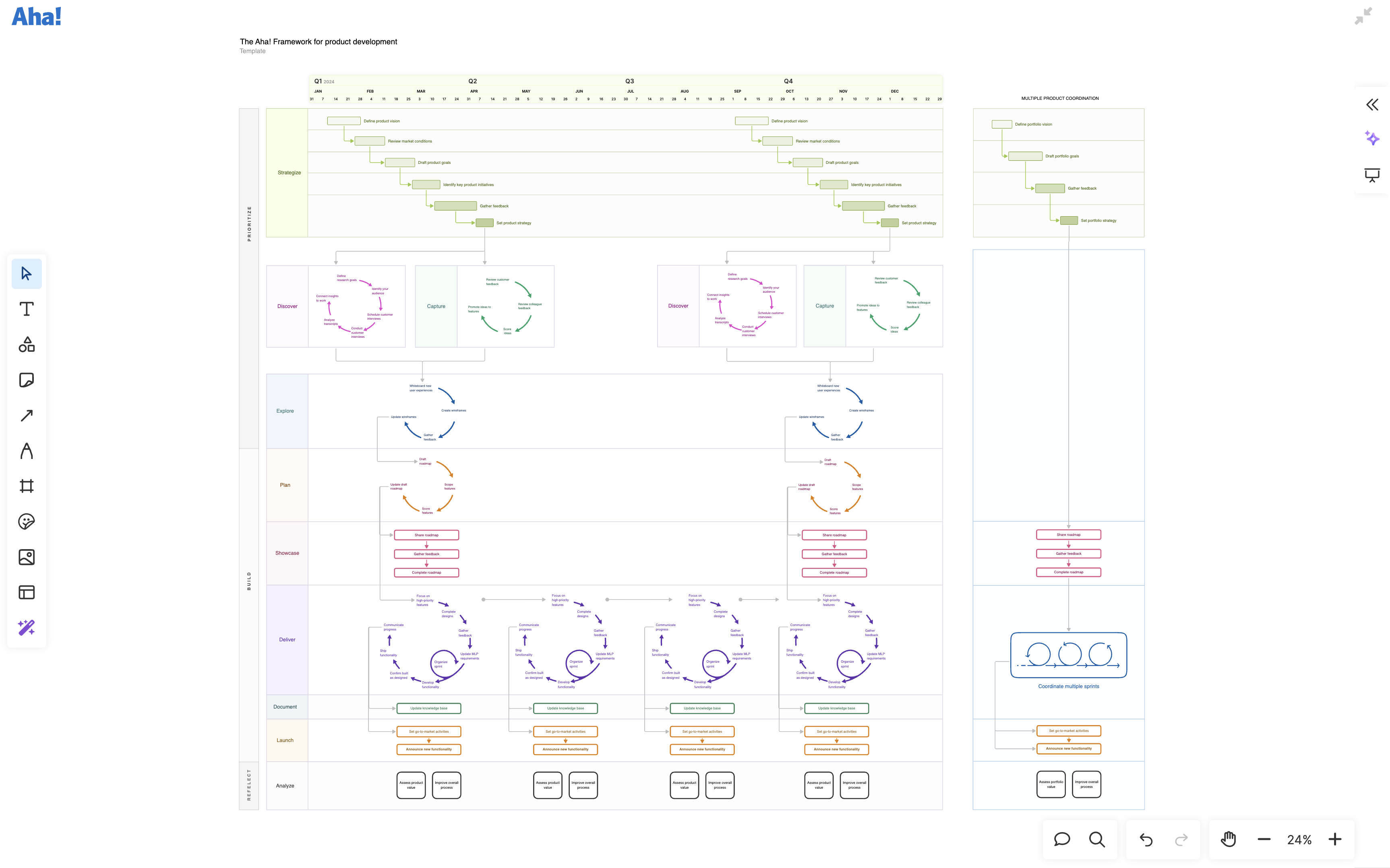The Aha! Framework for product development
Our proven model for delivering products that customers love
Updated: September 2025
The Aha! Framework is a flexible product development process. It gives product teams a way to set strategy, prioritize work, and achieve quickly — balancing long-term planning with agile delivery. Use this guide to explore the full methodology and the activities in each stage. |
The Aha! Framework for product development promotes a strategic approach to agile work. It is a flexible model that product organizations can leverage to improve efficiency and increase value delivered to customers.
The Aha! Framework ensures prescribed biannual strategic alignment while supporting ongoing sprints with continuous deployment. That is what makes it unique. We developed and have used the framework for more than a decade — it continues to power our product success.
Our goal when we founded Aha! in 2013 was to help organizations set clear strategy and connect it to the work of building products that customers love. We pioneered a new category with our first and now flagship product, Aha! Roadmaps. And our software currently serves more than 1 million product builders at many of the world’s most innovative and well-known companies. (If you have not yet tried Aha! software, you can start a free 30-day trial.)
But we did not explicitly share our own product development methodology for many years. So let's get into the details of The Aha! Framework. The content below is organized logically for folks who are new to the method. If you know what you are most interested in, you can also jump ahead to any section:
Why standardize work with a product development methodology?
What are the pros and cons of current product development methodologies?
Why a strategic approach to product development is better for most teams
Why standardize work with a product development methodology?
Before we get into what we believe is the best way to develop products, it is worth reviewing why you need a way to do so at all. Remember that breakthroughs are rare. And despite the mythologies that exist about flashes of insight or “eureka” discoveries, real innovation is almost always the result of careful research and planning. You choose a product development methodology because it gives people a process for achieving repeatable success.
Product development is complex. The process of setting strategy, discovering what customers want, brainstorming, planning, building, releasing a product to market, and measuring its success is inherently fraught with hurdles. Myriad teams and stakeholders provide insights and produce results. It is a collective effort that requires close collaboration and tight coordination.
Now, there is no doubt that it is hard to align groups of people on how they should work. Adopting a new methodology is a major investment for any organization. Very few companies adopt one before building anything — so you have the added challenge of integrating the new way of working with in-progress projects and entrenched habits. This kind of shift represents a significant collective effort, one which often requires education and reskilling for teammates. But the reward should outweigh the effort and any pain along the way.
What are the pros and cons of current product development methodologies?
The amount of software being developed today is staggering. So it is somewhat surprising that there are just a handful of named product development methodologies used by the majority of teams.
We can divide these methods into two groups: sequential (waterfall) and iterative (agile). The majority of the frameworks you are likely familiar with fall into the latter category. Agile is not a prescribed technique, but rather a term used to refer to certain values and a mindset.
For the sake of brevity, we will focus on the most common approaches that we know product development teams use: kanban, Scaled Agile Framework® (SAFe®), scrum, and waterfall. The table below is in alphabetical order and provides a basic description of each method along with pros and cons.
Methodology | Pros | Cons |
Kanban Kanban is a workflow management system that helps agile software development and product teams define and manage work and continuously improve performance. Each card on a kanban board represents a work item. A team's kanban board is always in motion, and new cards are pulled from the backlog and added to in-progress work as team capacity allows. Related: What is kanban? |
|
|
SAFe® SAFe is a comprehensive set of guidelines for implementing agile and lean principles at scale. The framework was developed and launched by Scaled Agile Inc. in 2011. SAFe puts forth a set of values and principles that can be applied across the different levels of an enterprise, from individual teams to broad portfolios. |
|
|
Scrum Scrum is one of the most popular agile frameworks. Founded on empiricism, scrum relies on self-managing teams working collectively to consistently deliver value at a sustainable pace. Scrum is organized around a set of theories, values, and practices. Scrum teams have no imposed hierarchy within the group, with just two defined roles of scrum master and product owner. Related: What is scrum? |
|
|
Waterfall Waterfall is a sequential model for planning, building, and delivering new products and features. Each phase of development must be documented and approved before the next phase can begin. There are no defined theories, values, roles, or ceremonies in waterfall. The focus on logical progression of steps completed sequentially is meant to ensure projects are completed within budget and on time. |
|
|
Why a strategic approach to product development is better for most teams
Almost everyone today dismisses sequential waterfall approaches as too outdated and rigid for software development. Agile methods are celebrated because there is an assurance of total flexibility, with more control given to the people doing the work. However, teams often get lost in agile because there are no clear strategic goals and initiatives to guide that work. This lack of structure can lead to moving quickly — yet not building what will actually create the most value.
So folks seek out methods that promise the speed of agile with the predictability and goal-first focus of waterfall. Some end up with painstakingly complex methodologies where the process becomes the work. Others cobble together a homegrown approach that leverages legacy workflows with agile practices awkwardly layered on top. Neither one is ideal nor conducive to developing lovable products.
After working with hundreds of product development teams, we can confidently let you in on a little secret — no one is strictly adhering to any of these methodologies. (Yes, that includes SAFe.)
Most product leaders bemoan the struggles of trying to get the team to follow a specific methodology. The main complaint is that ultimately, the organization does not ship as quickly as it would like and on a cadence that benefits customers.
But there are other consistent themes:
There is no strategic alignment.
It is difficult to uncover and implement customer insights.
Processes are not clearly documented.
The team does not fully embrace the process.
Different groups work differently.
There is too much bureaucracy.
Too much time is spent in meetings talking about work vs. just doing it.
Transparency into team efficiency and value created is impossible.
The reality is that most folks benefit from an agile-ish approach that is grounded in strategy. You need defined goals to work toward, clear processes and work ownership, the flexibility to improve over time, and the responsibility to measure the value of what you deliver.
This is what we have done at Aha! for a long time. We borrowed areas of strength from different existing methods while leaving the challenges behind.
What is The Aha! Framework for product development?
The Aha! Framework for product development is the engine that has powered our success for the last 10+ years. It is core to our company’s growth and position as market leader for product development software.
Our success hinges on our commitment to building what customers actually value, and doing it fast. The Aha! team ships enhancements and new features that customers value daily. It also delivers uber-responsive support, with around-the-clock guidance delivered in typically less than two hours.
We achieved this by pioneering a new concept in 2013: Minimum Lovable Product (MLP). The MLP is a rebuttal to the minimum viable product (MVP). We believe the MLP is superior, as the MVP puts emphasis on building only what is viable (or what people will tolerate) rather than what will inspire love.

A year after introducing MLP, we codified a framework for personal and business success. The Responsive Method (TRM) is centered around the belief that interactions with urgency propel people and organizations forward. Our perspective was further expanded upon in Aha! co-founder and CEO Brian de Haaff's bestselling 2017 book, Lovability.
Company leaders frequently come to us interested in bringing the Aha! value-first product development approach to their teams. These folks often use a workflow or methodology that is designed for predictability, but does not deliver the value they hoped for. They are looking for a better way forward — and ask how we approach product development.
We have always been willing to share our guidance and knowledge so others can benefit. Documenting product development resources was something we began doing early on in the company's history. Since then, we have published hundreds of blog posts along with a comprehensive guide for product managers on the Aha! website.
The Aha! Framework is a defined and proven model for product development. The goal is to deliver an MLP. The framework blends upfront strategic planning with the rapid delivery of agile, putting an emphasis on value creation. This approach was integral to the successful development of all products in the Aha! suite: Aha! Roadmaps, Aha! Discovery, Aha! Ideas, Aha! Whiteboards, Aha! Knowledge, and Aha! Develop.
We know that The Aha! Framework for product development works. And we know that many product teams are looking for a better way to plan, build, and launch products that customers love. So we are sharing the complete framework, both in this guide and directly in Aha! Roadmaps with dedicated functionality that teams can use to define how they work.
What are the activities in The Aha! Framework?
The Aha! Framework is organized around what we have defined as the 10 core stages of product development. Within each stage, there are discrete activities that support positive progress throughout the product development process. It starts with biannual strategic alignment and includes ongoing delivery.




